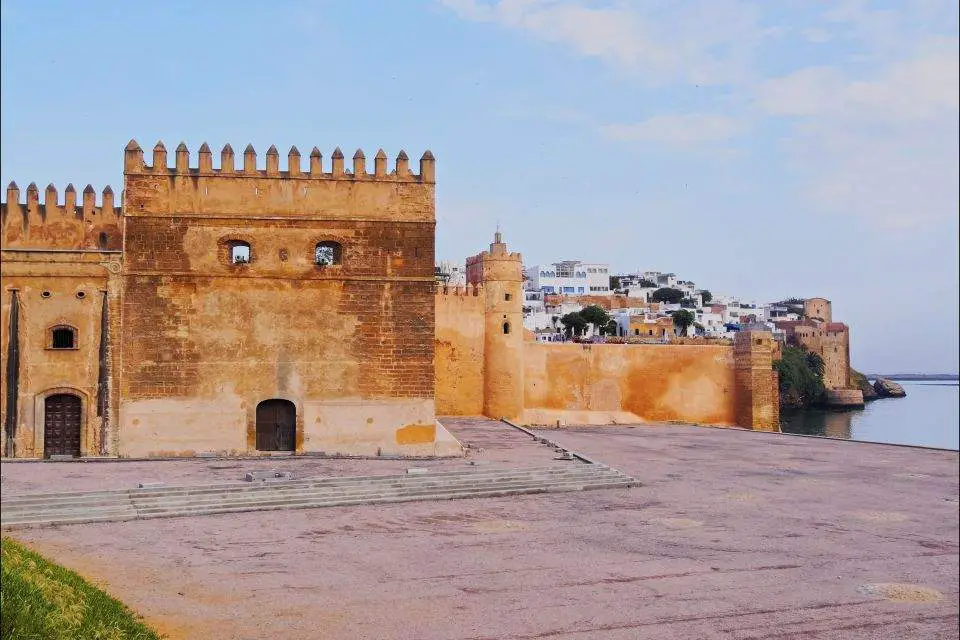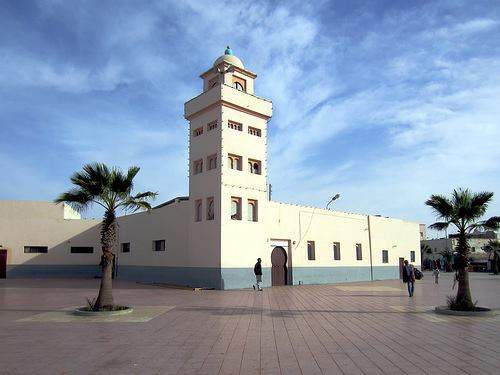Deciding which places to see in Rabat in two days or a weekend is the first thing that comes to mind when you find that flight offer to which you (fortunately) have succumbed. You’ve got your tickets to visit Morocco’s political capital and main administrative centre, and you’re in for a thrill.

Here are the best places to stay in Rabat.
Get the best deals and discounts on hotels here.
Must see in Rabat in two days
Riding the boat from Salé

If you want to save on your trip to Rabat, take a look at the list of hotels in Rabat and Salé and book one in the Salé area, if possible near the Madrassa des Merinides. Although at first I thought it would have been better to sleep in Rabat, now I recommend you to sleep in Salé.
From there you can cross the river to Rabat by boat for 2.5 dirhams per person (about 0.25 euros), see the Kasbah des Udayas from outside (the best), walk around the neighborhood where the rabbis really live and be amazed by the cemetery of Salé (a pleasant surprise). I liked the walk so much, that every time we went from Salé to the centre we did it in this boat, except the first afternoon when we paid the hazing and went by taxi. Also to return from the center to Salé, it is best to take the boat.
The Kasbah des Oudayas, a must see

The Kasbah des Udayas is a fortified enclosure on the shores of the Atlantic. The Oudaya Arab tribe settled there in the 13th century to protect the city, hence its name. To access the kasbah, you will pass through a gate from the time of the Almohads. Here you will find the oldest mosque in Rabat, dating from the 12th century.

The best thing is to get lost in its blue and white tinted streets, I’m sure you’ll take your camera out many times. Don’t leave without looking at the viewpoint, located on a large esplanade, overlooking the beach of Rabat on one side of the river and the beach of Salé on the opposite side. And to top it off, the Andalusí Garden, a haven of peace with red walls, fountains, exotic trees and orange trees. Without a doubt, the Kasbah is my favorite place to see in Rabat in two days.
Visit the Rabat Souk

Near the Kasbah is the medina and the area that cannot be missed in any Moroccan city and that you must see in Rabat: the souk. Less crowded and smaller than the one in Marrakech, but it has the charm of being less touristy. This means that the sellers do not hesitate to pass by their shop.
Here, you won’t hear the famous phrase “friend, cheaper than Carrefour”, nor will you have to avoid the shopkeepers who try to sell you the unsaleable. Take a leisurely stroll, look at the handmade leather, wood and bronze objects and, above all, observe the day-to-day life of the rabbis. The main streets are Rue des Consuls and Rue Souika. I loved the Souk Tehti, where the prized carpets are sold.
If there’s one thing that’s not missing from all my trips, it’s a visit to the central market. Fruit, vegetables, olives, spices… Here you can see the bargaining in all its glory. The market in Rabat is not very big, but it is worth seeing the prices and the different varieties of local products.
Walk along Avenue Mohammed V
After visiting the central market, you will arrive at the main artery of Rabat. Avenue Mohammed V houses the new city (ville nouvelle) with large avenues, landscaped areas, government buildings such as the Parliament of Morocco, Embassies, the central train station, the beautiful post office building (la Grande Poste) and its clock (surprise, there is a time difference with Spain!) and the Hotel Balima, which is under renovation. This avenue is another must see in Rabat in two days.
Assounna Mosque

Very close to the Museum of Modern and Contemporary Art is the Assouna Ave Tachfin Mosque. If you are not a Muslim, you are not allowed to enter. However, it is interesting to see it from the outside.
Saint Peter’s Cathedral

After seeing the mosque, we go down Mohammed V Avenue (you have to retrace your steps a few meters) and on the right comes Abou Inane Avenue, which leads to St. Peter’s Cathedral. It is one of the few places of Catholic worship in Morocco. Made of white stone, construction began in 1919. The two bell towers date from the 1930s and their shape is quite peculiar. In the Cathedral they still have mass on Sundays.
Muslim cemetery of Sidi Benachir

What a surprise I had when I looked out over the wall and suddenly saw so many gravestones and the sea in the background. Tombs of different colours, with and without tiles, covered with earth so that flowers and plants can grow on them… The cemetery is in a privileged place and the views from there are unbeatable.
Great Mosque of Salé

The Great Mosque of Salé (Grande Mosquée) I could only see it from the outside because they don’t let you in if you are not a Muslim. Next to it is the 14th century Merini Madrasa of Salé. Built around a courtyard, it follows the Moroccan-Andalusian architectural style. I didn’t get in because of lack of time. It used to cost 10 dirhams (0.9 euros), now 70 (6.5 euros) so I was told there. In fact, the entrance to Ben Yousef’s Madrasa in Marrakech is cheaper. I leave you the prices of my trip to Marrakech below.
Hassan Tower

This tower is the minaret of a 12th century mosque that was never finished. Sultan Yacoub El Mansour intended to build the largest mosque in the Muslim world after the one in Samarra, Iraq. The work was stopped after his death in 1199. The idea was that the minaret would be over 60 meters long, although in reality it is 44.3 meters long. My trip to Rabat in two days coincided with the visit of Pope Francis, so the Hassan Tower was closed on Sunday because they were dismantling the event the day before. In the photo you can see the golden chairs they put for the people attending the mass. Doesn’t this tower remind you of the Koutoubia in Marrakech or the Giralda in Seville?
Mausoleum of Mohammed V

Next to the Hassan Tower is also the Mausoleum of Mohammed V (died 1961) and the graves of his sons, Prince Moulay Abdellah (died 1983) and King Hassan II, who died in 1999. As it is in the same enclosure as the Hassan Tower, I could not enter either because it was closed for the Pope’s visit – a pity!
Necropolis of Chellah, a must see in Rabat

Walking to get a good look at a city is fine, but sometimes you don’t have to force it. From the Mausoleum of Mohammed V I decided to walk up to the Necropolis of Chellah. About 30 minutes walk uphill which in Petit Taxi costs about 12 dirhams (1.10 euro). My decision to walk was to get to know this less touristy part of the city, but it doesn’t pay off. You’ll really only see embassies and ministries that will make you think, “what have I done wrong in life?”
Chellah is a fortification that houses the ancient Roman city of Sala, with ruins such as a forum, a hammam, the capitol, a mosque, some gardens… For several centuries it was abandoned until it became a necropolis, where the first Merinidian sultans are buried. It is quite impressive to find this mixture of Phoenician, Carthaginian, Roman and Arab cultures in one place. Before the entrance cost 10 dirhams (0.9 euro) and now it has been increased to 70 dirhams (6.5 euro). By the way, I have never seen so many storks, in total there are about 75 nests inside the enclosure and another 25 outside by the wall. For me it is a must to see in Rabat in two days. Don’t leave without visiting Chellah.
Hassan II Park
Sometimes sightseeing takes you to the most remote places without you wanting it. I had read that the restaurant of the Sofitel Hotel was very rich and had affordable prices for the quality it offers. Well, we took a bike-taxi for 30 dirhams (2.8 euros) for a stretch of about 500 meters, we arrived at the hotel and the buffet menu at first I understood that it was 42 dirhams and I thought it was great, but I had to add a zero at the end, 420 dirhams (39 euros). For Morocco, it seemed very expensive and we left. As there was nothing in that area, we had to walk back along the same street we had taken by bike-taxi (all very logical as you can see). The fact is that we could see the Hassan II Park, similar to the Juan Carlos I Park in Madrid, with many green areas, places to skate, skateboard, etc.
Royal Palace outside (Dar-al-Mahkzen)

On the way back, apart from seeing the Hassan II Park, we could see the wall of the Royal Palace. Inside there is a small city, with a large mosque, several government buildings, Mechouar Square and wide avenues. To enter, you will have to go to one of the side doors, where you will be asked for your passport and, once you have written down your details, you will be able to enter. Unfortunately, it is not possible to enter the Royal Palace.
Where to eat in Rabat
During my trip to Rabat in two days, I tried a couple of local restaurants that I loved. My favorite dish is pastry (they write Pastilla) and of course I ordered it from both places.
Dar El Medina
Located in the middle of the medina, in the Souk Sebbat, this restaurant is in an oasis in the middle of the chaotic souk. Here we order a seafood cake, a chicken and vegetable couscous, a large bottle of water and chips for 220 dirhams (20,3 ? two persons). What I liked best was the couscous.
Dar Naji
Very close to the Bab El Had gate is my favorite restaurant in Rabat. Very economical prices, tasteful decoration and Arabic music in the background. The value for money is excellent. Here we order a chicken pie, a meat and vegetable tajine, mixed meat skewers and a large bottle of water for 147 dirhams (13.5 euro two persons).
Where to sleep in Rabat
As I told you at the beginning, I stayed in a riad in Salé. I recommend this area because the accommodations are much cheaper and it also gives you the opportunity to take the boat ride to Rabat, see the Kasbah from outside and get to know Salé. Below I leave you a discount on Airbnb of up to 34 euros for being a reader of La Vida son Dos Viajes.
Discount code of 34 euros for booking from this link of La Vida son Dos Viajes
Another option is to look at a discounted hotel in Salé or Rabat if you prefer to be directly in the centre. Below, I leave you with the offers that are now available in hotels in Rabat and Salé so that you can choose the one you like best.
So far, all the information about the must-sees in Rabat in two days, I hope it has been useful and encourages you to prepare your escape to the Moroccan capital. Salam aleikum!
Read More:
Best Bars in Rabat
Rabat in 1 Day
Where To Stay in Rabat
Necropolis of Chellah in Rabat